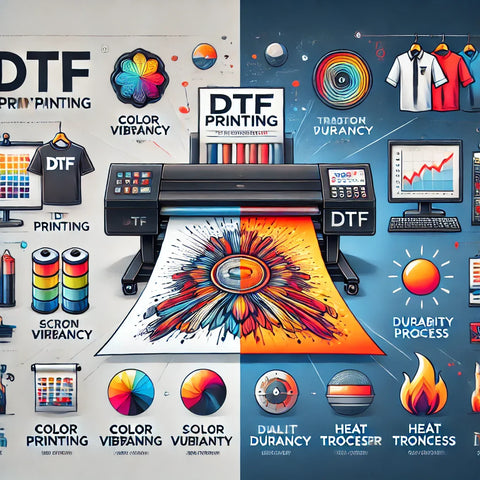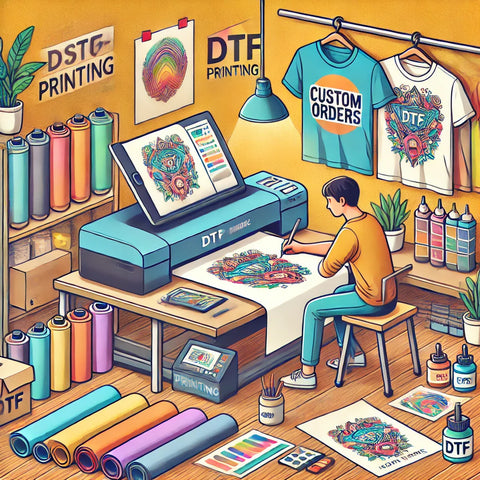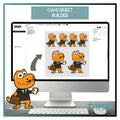Printing technology has evolved significantly over the years, offering businesses a variety of options for custom apparel and product decoration. While traditional printing methods like screen printing, DTG (Direct-to-Garment), and heat transfer vinyl (HTV) have dominated the industry for decades, DTF (Direct-to-Film) printing has emerged as a game-changing alternative.
But how does DTF printing compare to traditional techniques? Which method offers better quality, durability, and efficiency for different applications?
In this guide, we’ll explore the key differences between DTF and traditional printing, so you can make an informed decision for your e-commerce business, print shop, or custom apparel brand.
1. What is DTF Printing?
DTF (Direct-to-Film) printing is a modern digital printing method that involves printing a design onto a special PET film, applying a powder adhesive, and then heat-pressing it onto fabric.
Unlike traditional printing methods, DTF works on almost any fabric type (cotton, polyester, blends, leather, etc.), making it one of the most versatile and innovative printing solutions in the industry.
How DTF Printing Works:
1️⃣ Print the design on a PET transfer film using a DTF printer.
2️⃣ Apply adhesive powder to the printed design.
3️⃣ Cure the powder using a heat press or curing oven.
4️⃣ Transfer the design onto the fabric using heat and pressure.
Pro Tip: DTF prints are soft, flexible, and highly durable, making them a great alternative to other printing methods.
2. DTF vs. Screen Printing
Screen printing is one of the oldest and most widely used printing methods, especially for bulk orders and corporate branding. It involves pushing ink through a mesh screen stencil onto the fabric.
Key Differences:
| Feature | DTF Printing | Screen Printing |
|---|---|---|
| Fabric Compatibility | Works on all fabrics (cotton, polyester, blends, etc.) | Best for cotton and blended fabrics |
| Setup Cost | Low (no screen setup needed) | High (requires separate screens for each color) |
| Order Size Suitability | Great for small and large orders | Best for bulk production |
| Design Complexity | Full-color, high-detail, gradients possible | Limited colors, no gradients |
| Durability | Excellent stretchability and wash resistance | Very durable, but ink may crack over time |
| Cost Efficiency | More cost-effective for small orders | Cheaper for large-volume orders |
✅ Best for: Small businesses, custom one-off designs, multi-color prints.
❌ Not ideal for: Large-volume orders where screen printing remains more cost-effective.
Pro Tip: If you need bold, solid colors for bulk orders, screen printing is a better option. However, if you need detailed, full-color prints on multiple fabric types, DTF is the way to go.
3. DTF vs. DTG (Direct-to-Garment) Printing
DTG (Direct-to-Garment) printing works like an inkjet printer, spraying water-based ink directly onto fabric. It’s commonly used for small-batch, high-detail prints.
Key Differences:
| Feature | DTF Printing | DTG Printing |
|---|---|---|
| Fabric Compatibility | Works on all fabrics | Works best on 100% cotton |
| Print Durability | Resistant to cracking, peeling, and fading | Fades faster on polyester |
| Pre-Treatment | No pre-treatment needed | Requires pre-treatment for dark fabrics |
| Setup Time | Fast and easy | Requires fabric prep and drying |
| Color Vibrancy | Extremely vibrant | Good, but less saturated than DTF |
| Production Speed | Faster | Slower due to ink absorption and drying |
✅ Best for: Businesses needing full-color designs on various fabric types.
❌ Not ideal for: Businesses focused only on cotton garments, where DTG still works well.
Pro Tip: DTF is the superior option for diverse fabric printing, while DTG is best suited for soft, cotton-based apparel like t-shirts.
4. DTF vs. Heat Transfer Vinyl (HTV)
Heat Transfer Vinyl (HTV) is a cut-and-press method where pre-colored vinyl sheets are cut into shapes and heat-pressed onto fabric. It’s often used for sports jerseys, team uniforms, and promotional apparel.
Key Differences:
| Feature | DTF Printing | HTV (Heat Transfer Vinyl) |
|---|---|---|
| Design Customization | Full-color, intricate designs | Solid-color, cut-out designs |
| Durability | Soft feel, flexible, long-lasting | Can feel thick and peel over time |
| Fabric Compatibility | Works on all materials | Limited to smooth surfaces |
| Production Speed | Fast | Slower (cutting and weeding required) |
| Cost Efficiency | Cost-effective for detailed designs | Cheaper for simple, single-color logos |
✅ Best for: Businesses needing complex, multi-color graphics without the hassle of cutting and weeding.
❌ Not ideal for: Simple name/number prints, where HTV is faster and more cost-effective.
Pro Tip: DTF offers better comfort and durability than HTV, making it the preferred choice for high-end custom apparel.
5. DTF vs. Sublimation Printing
Sublimation printing uses heat to turn ink into gas, which chemically bonds with polyester fabrics or coated surfaces like mugs and phone cases.
Key Differences:
| Feature | DTF Printing | Sublimation Printing |
|---|---|---|
| Fabric Compatibility | Works on all fabrics | Only works on light-colored polyester |
| Print Durability | Long-lasting, flexible | Permanent but fabric-limited |
| Product Variety | Apparel, accessories, and more | Apparel + hard surfaces like mugs |
| Color Vibrancy | High-quality, rich colors | Bright, vivid colors on polyester |
✅ Best for: Businesses printing on all fabric types.
❌ Not ideal for: Businesses printing on polyester-exclusive materials, where sublimation shines.
Pro Tip: Use sublimation for mugs and polyester apparel but DTF for a broader product range.
Final Thoughts: Which Printing Method is Right for You?
Choosing between DTF and traditional printing methods depends on your business needs, order volume, and product variety.
📌 Key Takeaways:
✔ DTF is the most versatile – works on all fabrics with durable, vibrant prints.
✔ Screen printing is best for bulk orders but lacks color flexibility.
✔ DTG is great for cotton-based designs but slower than DTF.
✔ HTV works well for simple designs but lacks the detail and flexibility of DTF.
✔ Sublimation is ideal for polyester and hard surfaces but doesn’t work on cotton.
🚀 Looking for high-quality DTF transfers? Upgrade your printing business today and enjoy the next generation of custom printing!






